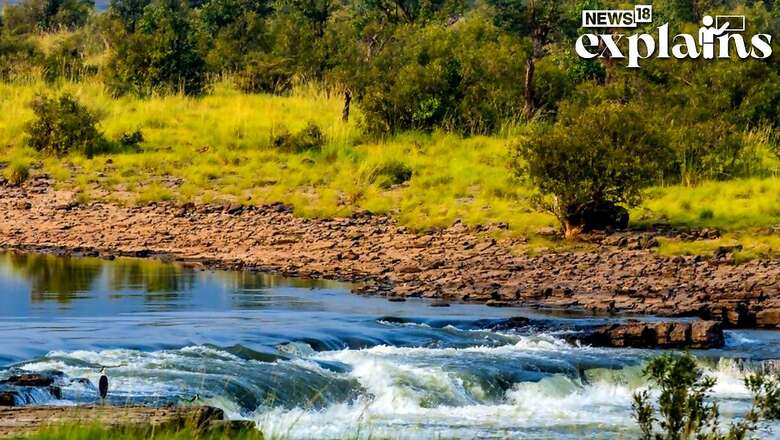Ken-Betwa Link Project to Get Green Light: Why it is Significant & What is Govt's River Linking Plan

views
Prime Minister Narendra Modi will be on visit to poll-bound Madhya Pradesh on Thursday (September 14) where he will inaugurate a slew of projects in the state.
The prime minister is expected to launch the Ken-Betwa Link Project (KBLP) and lay the foundation stone of petrochemicals complex of BPCL Bina refinery in Madhya Pradesh.
Ken-Betwa Link Project (KBLP), which got the Union Cabinet approval in December 2021, is a flagship project of the centre that is critical for the water security and socio-economic development of Bundelkhand region.
What is the Ken-Betwa link project?
The Ken-Betwa Link Project received the nod of the Union Cabinet in December 2021, as a part of government’s plan to connect rivers to enable water from surplus areas to address needs in drought-prone regions.
The project involves the transfer of water from Ken to the water-deficit Betwa river through the construction of a dam and a canal to link the rivers. The Daudhan Dam will be created on the Ken, within the Panna Tiger Reserve with a canal linking the two rivers with the project and flowing through Chhatarpur, Tikamgarh and Jhansi districts and irrigating 6.3 lakh hectares of land every year.
The project is structured to be completed in two phases. In the first phase, Daudhan Dam complex and its subsidiary units such as the Low-Level Tunnel, High-Level Tunnel, Ken-Betwa Link Canal, and powerhouses will be completed. In the second phase, there will be the construction of the Lower Orr Dam, Bina Complex Project, and Kotha Barrage, according to India Today.
What is the Significance of the Project
With the project, the government aims to benefit the water-starved Bundelkhand region, spread to several other districts of Madhya Pradesh and Uttar Pradesh. Nine districts of MP- Panna, Tikamgarh, Chhatarpur, Sagar, Damoh, Datia, Vidisha, Shivpuri, Raisen; and Banda, Mahoba, Jhansi and Lalitpur districts of UP will be covered by the project.
The completion of the project will pave the way for more interlinking of river projects in India, the government has said. It will also help generate 34 million kilowatts of hydropower.
The project is expected to boost socio-economic prosperity in the backward region of Bundelkhand, on account of increased agricultural activities and employment, which will help in reducing the migration from the region.
Cost of Project
In December 2021, the Union Cabinet approved Ken-Betwa River link project at a total cost of Rs 44,605 crore and Union Finance Minister Nirmala Sitharaman allocated the money for the implementation in the Union Budget 2022.
The Union Cabinet has approved central support of Rs 39,317 crore towards its development, which comprises a grant of Rs 36,290 crore and a loan of Rs 3,027 crore. The project is expected to complete in eight years.
What is National River Linking Project?
Ken-Betwa interlinking is the first project to be taken up as part of the National River Linking Project (NWLP). The project aims at providing storages and transfer of surplus waters to water deficit regions so as to mitigate the effect of annually recurring floods and also to minimise the incidence of droughts.
As a part of the NWLP project, Ministry of Jal Shakti has identified 16 links under peninsular rivers component and 14 links under Himalayan component for inter basin transfer.
Some of the rivers that are part of the government’s plan are Damanganga-Pinjal, Par-Tapi-Narmada, Godavari-Krishna, Krishna-Penner and Pennar-Cauvery.
As of December 2022, the National Water Development Agency has received 49 link proposals from 10 states, out of which pre-feasibility reports of 39 link projects and detailed project reports of six link projects were completed and sent to states concerned.
Concerns Regarding the Project
The Bundelkhand region is home to the critically endangered vulture and gharial and other species like leopard, sloth bear among others. According to reports, over 9,000 hectares will be submerged for the project. Of this, 6,000 hectares are part of the Panna tiger reserve in Madhya Pradesh.
Panna tiger reserve lost all its tigers by 2009 and it took hard work of almost a decade to reintroduce them. It is feared that the deep gorges, that make Panna an exceptional tiger habitat, will be drowned if the new dam is built.
Some reports have also said that there might not be enough water in the Ken, a non-perennial river, to meet the projected needs of the Betwa and it would not be enough to fulfil the requirement of the Bundelkhand region, according to a report in The Hindu. The project works will also involve felling over 20 lakh trees.

















Comments
0 comment